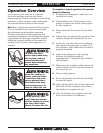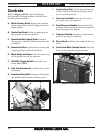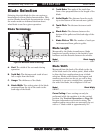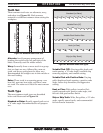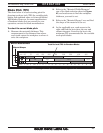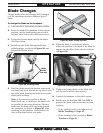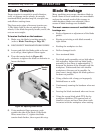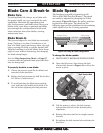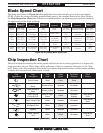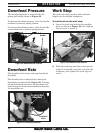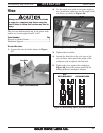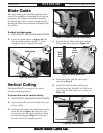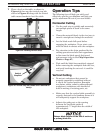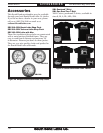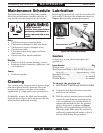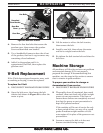
For Machines Mfg. Since 8/09 Model SB1017
-27-
OPERATION
Blade Speed Chart
Figure 32. Dry cutting blade speed chart.
Copper
Alloy
229~482
(70) (147)
203~213
(62) (65)
85-203
(26) (62)
220
(67)
220~534
(67) (163)
203
(62)
85
(26)
321
(98)
180~220
(54) (67)
95~213
(29) (65)
242
(75)
65~85
(20) (26)
180~220
(54) (67)
75~118
(25) (36)
246
(75)
108~225
(33) (75)
196~354
(60) (108)
203
(62)
111~321
(34) (98)
150~203
(46) (62)
Aluminum
Alloy
Thin
Tube
Angle
Steel
Carbon
Steel
Speed FPM
(M/Min)
Speed FPM
(M/Min)
Speed FPM
(M/Min)
Speed FPM
(M/Min)
Material Material Material Material
Tool Steel
Mold Steel
High-Speed
Tool Steel
Alloy
Steel
Water
Hardened
Tool Steel
Stainless
Steel
CR Stainless
Steel
Free Machining
Stainless Steel
Gray
Cast Iron
Ductile
Austenitic
Cast Iron
Malleable
Cast Iron
Plastics
Cold-Work
Tool Steel
Hot-Work
Tool Steel
Oil-Hardened
Tool Steel
CUTTING SPEED RATE RECOMMENDATION
The blade speed chart in Figure 32 offers guidelines for various metals, given in feet per minute
(FPM). Choose the closest available machine blade speed to the number shown in the chart. Refer to
the Chip Inspection Chart that follows for recommendations on adjusting your operation based on
the appearance of the chips produced
Chip
Appearance
Chip
Description
Chip
Color
Blade
Speed
Feed Rate/
Pressure
Other
Actions
Thin & Curled Silver Good Good
Hard, Thick &
Short
Brown or Blue Increase Decrease
Hard, Strong &
Thick
Brown or Blue Increase Decrease
Hard, Strong,
Curled & Thick
Silver or Light
Brown
Good
Decrease
Slightly
Check Blade
Pitch
Hard, Coiled & Thin Silver Increase Decrease
Check Blade
Pitch
Straight & Thin Silver Good Increase
Powdery Silver Decrease Increase
Coiled, Tight &
Thin
Silver Good Decrease
Check Blade
Pitch
thin & curled
short, hard & thick
thick, hard & strong
thick, hard & strong
thin & straight
powdery
thin & curled tightly
hard & thin
thin & curled
short, hard & thick
thick, hard & strong
thick, hard & strong
thin & straight
powdery
thin & curled tightly
hard & thin
thin & curled
short, hard & thick
thick, hard & strong
thick, hard & strong
thin & straight
powdery
thin & curled tightly
hard & thin
thin & curled
short, hard & thick
thick, hard & strong
thick, hard & strong
thin & straight
powdery
thin & curled tightly
hard & thin
thin & curled
short, hard & thick
thick, hard & strong
thick, hard & strong
thin & straight
powdery
thin & curled tightly
hard & thin
thin & curled
short, hard & thick
thick, hard & strong
thick, hard & strong
thin & straight
powdery
thin & curled tightly
hard & thin
thin & curled
short, hard & thick
thick, hard & strong
thick, hard & strong
thin & straight
powdery
thin & curled tightly
hard & thin
thin & curled
short, hard & thick
thick, hard & strong
thick, hard & strong
thin & straight
powdery
thin & curled tightly
hard & thin
Figure 33. Chip inspection chart.
The best method for choosing the cutting speed and feed rate for a cutting operation is to inspect the
chips created by the cut. These chips will be indicators of what is commonly referred to as the "chip
load". Refer to the chip inspection chart below to evaluate chip characteristics and determine whether
to adjust feed rate/pressure, blade speed, or both.
Chip Inspection Chart



